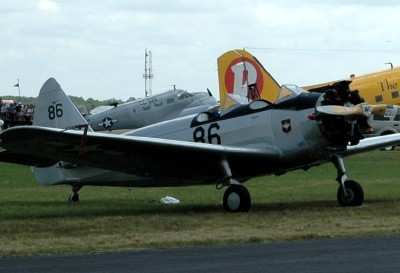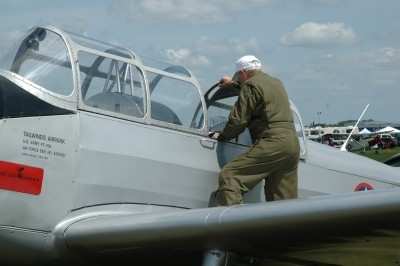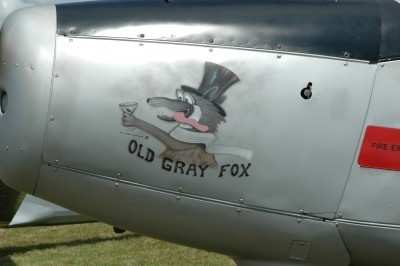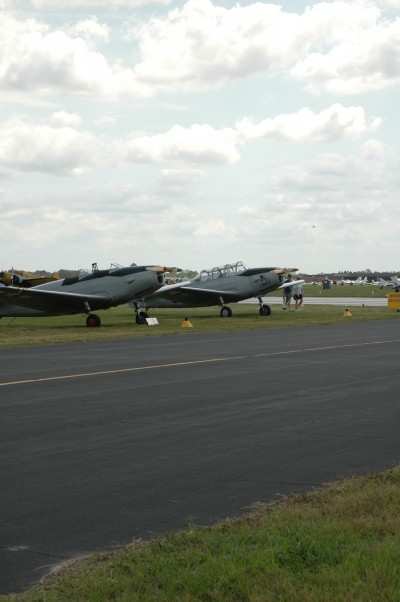Training Was The Allies' Secret Weapon
 If you ask a lot of people which
type did the most to win the Second World War, some of them would
certainly name the mighty B-29 that nuked the Banzai clean out of
the Japanese Empire. Some would suggest the fleets of B-17s which
bombed German industry to a standstill. Some would point to the
fighters that swept the skies clean of Axis warplanes and let the
bombers do their deadly work.
If you ask a lot of people which
type did the most to win the Second World War, some of them would
certainly name the mighty B-29 that nuked the Banzai clean out of
the Japanese Empire. Some would suggest the fleets of B-17s which
bombed German industry to a standstill. Some would point to the
fighters that swept the skies clean of Axis warplanes and let the
bombers do their deadly work.
So, which plane did the most to win the war? Well, in one way of
looking at it, you're looking at it. This row of Fairchild primary
trainers is reminiscent of the World War II photographs of hundreds
of the gentle beasts sitting on the training fields which
mushroomed across the Sun Belt in 1941-43.
The Fairchild was the introduction to aircraft for many, perhaps
most, of the hundreds of thousands of American pilots who would man
the fighters and bombers that made that decade's history.
Innumerable first flights, first solos, and flying adventures were
had in these trainers.

If only they could speak!
The Fairchild was originally selected "off the shelf" before the
actual start of the war as a modern monoplane, intended to replace
the elderly Boeing PT-13 and PT-17 biplane trainers in Army Air
Corps service. The massive explosion in flight training in the
early war years, though, meant that the Stearmans stayed in
production as other types of trainer were also pressed into
service. The ultimate product, though, was the largest effective
air force ever trained in the history of the world.
Each of the many versions of the Fairchild had a different Air
Corps type number. The original PT-19A was an open-cockpit airplane
innocent of any vacuum gages or electrical system. With no lights
and few instruments beyond a fuel gage, altimeter and airspeed, it
was a day VFR plane, full stop; almost four thousand of the were
built. The B model added venturi-driven blind flying
instrumentation. Other variants included the PT-23, powered by a
220 HP Continental R-670 radial due to production of the PT-19's
Ranger L-440 falling short, and the PT-26, Ranger powered like the
PT-19 but with an enclosed canopy.

The PT-26 was built at first as the Cornell for the Commonwealth
Air Training Scheme, in which thousands of RAF airmen were trained
in safe (but cold) Canada. Over 670 of the machines were provided
to the Royal Canadian Air Force for this purpose. Why the Cornell?
The British named their trainers after universities -- when they
adopted American trainers, they named them after *American*
universities.

Joe Miller, based at Tailwinds Airpark in Jupiter, Florida, is
the owner and present custodian of PT-19, which resembles a PT-26
because a PT-26 canopy has been added. His is finished in the
silver dope with red-rimmed national insignia, as it would have
looked in about 1943 -- sixty-two years ago; a baby born then is
old enough for Social Security.

"It's a sweet-handling airplane," said Miller, whose plane is
marked with "Gray Fox" nose art. "Very gentle, barely breaks at the
stall, just a ball to fly with no vices." He's very proud of his
PT-19, which is evident in its gleaming condition. And he is a
walking encyclopedia of Fairchild lore: where I congratulate myself
for telling a Fairchild from a Ryan (another series of monoplane
trainers, noted for much less benign handling in the stall), Miller
can explain the difference between the models with perfect
accuracy.
Joe Miller had an interesting Navy career. Unlike most retired
Naval officers, he wasn't an aviator. "No, I was in air traffic
control. I started out as a mechanic, but then I switched to air
traffic control.
And then they offered me a commission, and I took it."
So you went all the way from Seaman Apprentice to Lieutenant
Commander?
"I went through every one of the enlisted grades, E-1 to E-9,
but I was never an ensign. They commissioned me directly to O-2
(Lieutenant Junior Grade)." All in all, Joe Miller served his
country for 30 years as a sailor and Naval officer, and then went
on to a second career in industry. Now retired from both, he enjoys
flying his World War II trainer in the sunny Florida skies. During
the war, the trainers used by hard-working training units were
never this well kept. And none of these anonymous machines,
distinguished one from the other only by different numbers, would
have worn nose art. But you can't judge Joe Miller the
pleasure.

The training system of the Western Allies was highly
systematized. Pilot candidates would begin in Primary trainers,
learning basic flying skills; graduate to Basic trainers, where
they began to learn and practice specific military flying skills;
and graduate to Advanced trainers, which began to prepare them for
their ultimate transition to high-performance combat aircraft.
The Axis nations had a much less finely graduated and
progressive training system. They had large numbers of extremely
well-trained combat airmen at war's beginning, but as the war went
on, their training base was unable to keep up, and Allied pilots
became keenly aware of the declining quality of the opposition
aircrews. A particular problem on the Axis side was the general
lack of a an intermediate trainer; a pilot might go from a 100-knot
biplane to a frontline fighter or bomber. As training goes, it was
the ""total immersion" variety: "sink or swim."
No wonder the allies won. And the path to victory started, more
often than not, in a little silver, or blue and yellow,
trainer.
 ANN's Daily Aero-Linx (04.16.24)
ANN's Daily Aero-Linx (04.16.24) Aero-News: Quote of the Day (04.16.24)
Aero-News: Quote of the Day (04.16.24) Airborne 04.10.24: SnF24!, A50 Heritage Reveal, HeliCycle!, Montaer MC-01
Airborne 04.10.24: SnF24!, A50 Heritage Reveal, HeliCycle!, Montaer MC-01 Airborne 04.12.24: SnF24!, G100UL Is Here, Holy Micro, Plane Tags
Airborne 04.12.24: SnF24!, G100UL Is Here, Holy Micro, Plane Tags Airborne-Flight Training 04.17.24: Feds Need Controllers, Spirit Delay, Redbird
Airborne-Flight Training 04.17.24: Feds Need Controllers, Spirit Delay, Redbird








